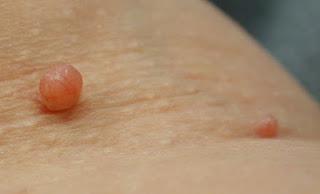These growths (known by a variety of names including acrochordon, cutaneous tag, soft fibroma, fibroepithelial polyps, and more) have been estimated to affect a considerable percentage of the population (estimates vary with some saying that up to 50% of the population is affected by them). The good news is that they are considered benign and there are now many options for removing skin tags.
The main cause is believed to be rubbing of the flesh, as they appear mainly in folds such as the armpits, under the breasts, neck, groin and eyelids. Obese individuals are more likely to develop them, probably because they have meatier folds. They also occur in pregnant women, although these types generally disappear a few months after pregnancy. Type 2 diabetes also tends to increase their appearance.
The use of illegal steroids can also be related to the growth of the tags, since a binding of the collagen fibers occurs with the use of steroids. Heredity has also been identified as a cause and they are more common in older people. They occasionally develop in children, but this is unusual. Microorganisms are also a suspicious cause, such as the wart virus. They have not become a research priority as they are generally harmless, so the specifics of the causes remain mostly unknown.
The growth can vary in size and shape, although they are generally the size of a grain of rice. They start out very small and grow over time. In some cases, the growth may be larger than a grain of rice. In very large tags, they may burst under pressure, but this is unusual. They are usually flesh-colored, but are sometimes darker in light skinned individuals. They look like chunks of meat hanging down.
Although some medical providers may order a biopsy, the diagnosis is usually made based on your appearance. Although it is generally painless, if the skin tag is constantly rubbed, such as between the legs, they can become irritated. They can also be pulled by jewelry, seat belts, or clothing. While they are generally considered harmless, they can be annoying and embarrassing.
While harmless, these growths can become irritated or unsightly and embarrassing. While some tags may just fall off, this is generally not the case. Now there are many removal options. There are medical procedures that include cutting, freezing, or burning. Skin tags on the eyelids can be more problematic for this type of removal.
The products are now available for consumers to remove these tags. Before purchasing one of these products, check for medical endorsements of the product and for money-back guarantees. Also check for consumer reviews of the product.
There are no known options to prevent these types of growths. Once removed, they can also grow back, so the removal process may require some repetition. If you opt for medical treatment, this can become an expensive, life long and time consuming option. Skin tags removal is a simple procedure with many home remedies to choose from. If these growths bother you, you can easily correct the problem.










